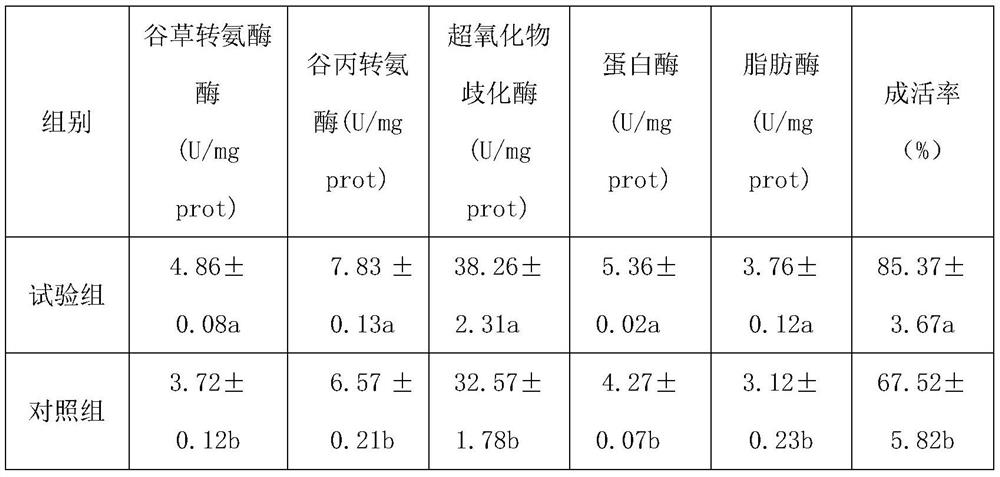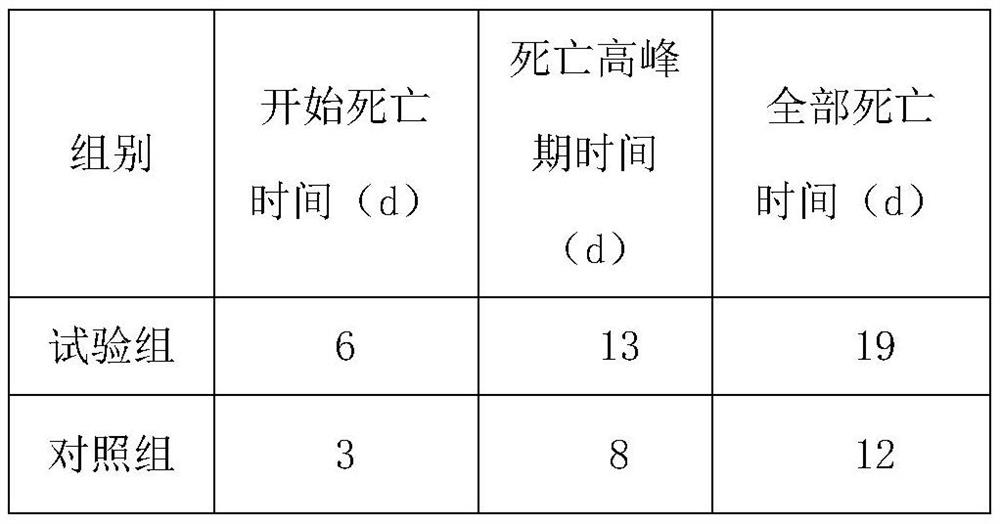Compound feed for preventing white spot virus syndrome of penaeus monodon as well as preparation method and application thereof
A technology of shrimp white spot virus and compound feed, which is applied in the field of compound feed and its preparation for preventing white spot virus syndrome of Penaeus monodon, can solve the problems of poor stability, low activity of fungi and microorganisms, and poor effect, and achieve the promotion of growth and metamorphosis , enhance the antioxidant capacity, and increase the effect of breeding benefits
- Summary
- Abstract
- Description
- Claims
- Application Information
AI Technical Summary
Problems solved by technology
Method used
Image
Examples
Embodiment 1
[0031] A compound feed for preventing white spot virus syndrome of Penaeus monodon, comprising the following components in parts by weight: 37 parts of domestic fish meal, 6 parts of chicken meal, 4 parts of cottonseed protein, 17 parts of soybean meal, 5 parts of peanut meal, low 19 parts of gluten flour, 3 parts of shrimp paste, 2.5 parts of soybean lecithin oil, 0.4 parts of Scutellaria baicalensis, 0.3 parts of Astragalus, 0.3 parts of Poria cocos, 0.4 parts of lutein, 2.21 parts of bentonite, 1 part of multi-vitamin and multi-mineral mixture, chlorine 0.2 part of choline, 1.6 part of calcium dihydrogen phosphate, 0.01 part of antioxidant, 0.08 part of antifungal agent for feed.
[0032]The preparation method is as follows: send the remaining components except the oil into the coarse powder machine for pulverization, and the raw materials with a pulverization fineness of more than 95% can pass through a 40-mesh sieve to obtain the coarse powder; the coarse powder and the oi...
Embodiment 2
[0036] A compound feed for preventing white spot virus syndrome of Penaeus monodon, comprising the following components in parts by weight: 37 parts of domestic fish meal, 6 parts of chicken meal, 4 parts of cottonseed protein, 17 parts of soybean meal, 5 parts of peanut meal, low 19 parts of all-purpose flour, 3 parts of shrimp paste, 2.5 parts of soybean lecithin oil, 0.3 parts of Scutellaria baicalensis, 0.3 parts of astragalus, 0.3 parts of poria cocos, 0.3 parts of rhubarb, 0.2 parts of tangerine peel, 0.2 parts of gallnut, 0.4 parts of lutein, 1.51 parts of bentonite 1 part of multi-vitamin and multi-mineral mixture, 0.2 part of choline chloride, 1.6 part of calcium dihydrogen phosphate, 0.01 part of antioxidant, 0.08 part of antifungal agent for feed.
[0037] The preparation method is the same as that of Example 1, and will not be repeated here.
[0038] The protein content of the compound feed prepared in this embodiment is about 40.5% to 43.5%, and the fat content is...
Embodiment 3
[0040] A compound feed for preventing white spot virus syndrome of Penaeus monodon, comprising the following components in parts by weight: 32 parts of domestic fish meal, 8 parts of chicken meal, 2 parts of cottonseed protein, 21 parts of soybean meal, 9 parts of peanut meal, low 18 parts of all-purpose flour, 1 part of shrimp paste, 5 parts of soybean lecithin oil, 0.2 parts of Scutellaria baicalensis, 1 part of Astragalus membranaceus, 0.2 parts of Poria cocos, 1 part of rhubarb, 0.2 parts of tangerine peel, 1 part of Chinese gall, 0.2 parts of lutein, 3 parts of bentonite 1 part of multi-vitamin and multi-mineral mixture, 0.5 part of choline chloride, 0.2 part of sodium chloride, 1 part of calcium dihydrogen phosphate, 0.03 part of antioxidant, 0.1 part of feed antifungal agent.
[0041] The preparation method is the same as that of Example 1, and will not be repeated here.
[0042] The protein content of the compound feed that present embodiment is made is about 39~41%, a...
PUM
 Login to View More
Login to View More Abstract
Description
Claims
Application Information
 Login to View More
Login to View More - R&D
- Intellectual Property
- Life Sciences
- Materials
- Tech Scout
- Unparalleled Data Quality
- Higher Quality Content
- 60% Fewer Hallucinations
Browse by: Latest US Patents, China's latest patents, Technical Efficacy Thesaurus, Application Domain, Technology Topic, Popular Technical Reports.
© 2025 PatSnap. All rights reserved.Legal|Privacy policy|Modern Slavery Act Transparency Statement|Sitemap|About US| Contact US: help@patsnap.com


